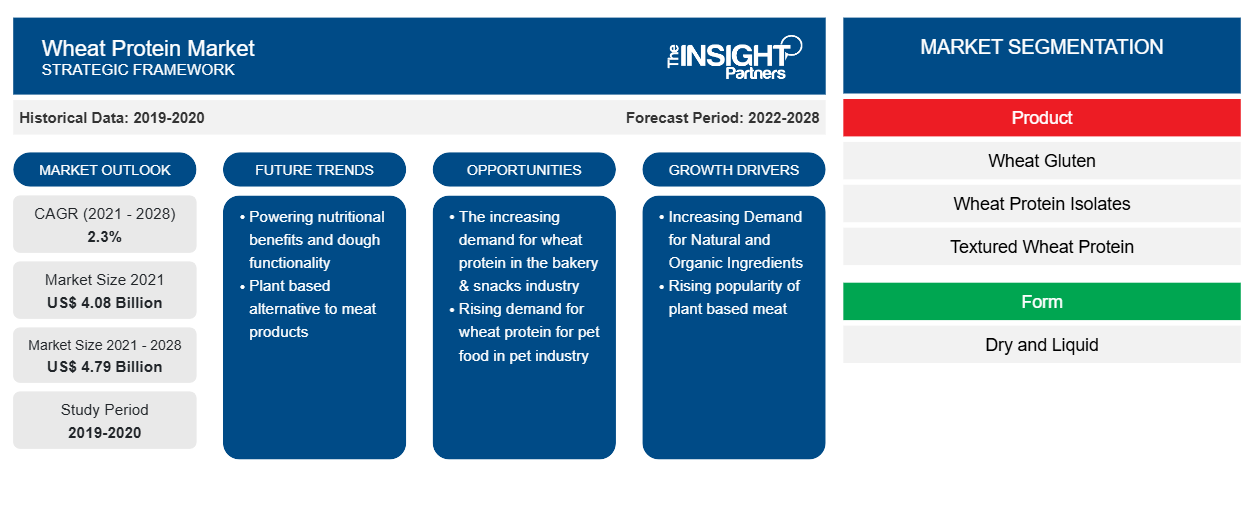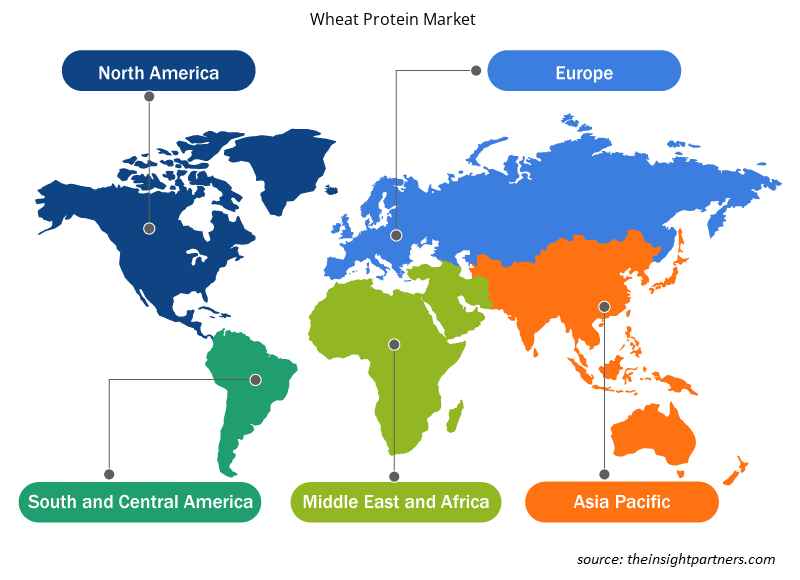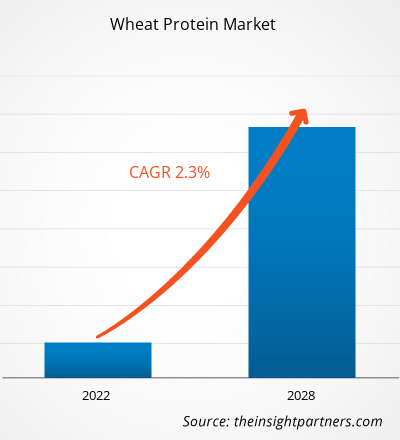[Research Report] The wheat protein market was valued at US$ 4,083.05 million in 2021 and is projected to reach US$ 4,788.49 million by 2028; it is expected to grow at a CAGR of 2.3% from 2021 to 2028.
Wheat proteins are plant-based proteins primarily obtained by processing wheat using different enzymes. They are insoluble functional proteins that possess unique visco-elastic characteristics and offer elasticity and extensibility to a final product. The proteins are considered a viable alternative for animal-based protein. They are widely used across several end-use industries, such as bakeries & confectionery, cosmetics & personal care, animal feed, and nutrition supplements.
In 2020, Europe held the largest revenue share of the global wheat protein market. The European market is segmented into Germany, France, Italy, the UK, Russia, and the Rest of Europe. Rising health awareness among consumers propels the demand for numerous plant protein products, such as soy, wheat, and oat. The popularity of the wheat protein has increased across the region, particularly in Germany, France, and the UK. Europeans are increasingly adopting the flexitarian diet, i.e., replacing part or most of their meat consumption with alternative protein food. These factors drive the demand for wheat protein products in Europe.
Customize This Report To Suit Your Requirement
You will get customization on any report - free of charge - including parts of this report, or country-level analysis, Excel Data pack, as well as avail great offers and discounts for start-ups & universities
Wheat Protein Market: Strategic Insights

- Get Top Key Market Trends of this report.This FREE sample will include data analysis, ranging from market trends to estimates and forecasts.
Customize This Report To Suit Your Requirement
You will get customization on any report - free of charge - including parts of this report, or country-level analysis, Excel Data pack, as well as avail great offers and discounts for start-ups & universities
Wheat Protein Market: Strategic Insights

- Get Top Key Market Trends of this report.This FREE sample will include data analysis, ranging from market trends to estimates and forecasts.
Many industries, such as the food & beverage industry, faced unprecedented challenges due to the COVID-19 pandemic. Due to shortage in raw material supply, the shutdown of factories, shortage of labor, and other difficulties in operations under COVID-19 safety protocols, companies involved in the manufacturing of wheat protein faced difficulties during the initial months of the pandemic. The food & beverage sector is the bulk consumer of wheat protein and the ongoing COVID-19 pandemic has negatively influenced the demand for wheat protein. Food and beverage products, such as bakery products, confectionery items, and dairy products, are being pushed back as the supermarkets have reallocated stock priorities toward staples and essential supplies due to the outbreak. However, as the economies are reviving their operations, the demand for wheat protein is anticipated to surge worldwide in the coming months. The COVID-19 pandemic has led to a raised demand for healthy and functional bakery products, which is expected to fuel the growth of the wheat protein market in the coming years.
Market Insights
Increasing Demand for Natural and Organic Ingredients
The importance of organic food items has been understood in the wake of alarming health issues, coupled with rising consciousness about organic certifications and growing preference for high-quality food items. Nowadays, consumers are looking for natural, clean, and simple ingredients with proper labels, which could effectively convey their contents, quality, and intent of the product use. Further, they are largely dependent on organic and natural food products. For instance, the consumption of organic wheat protein has been extensively rising in diverse application sectors, such as food & beverages, and animal and aqua feed. Thus, the manufacturers of wheat protein are focusing on developing and marketing organic wheat protein.
Product Insights
Based on product, the global wheat protein market is segmented into wheat gluten, wheat protein isolates, textured wheat protein, and hydrolyzed wheat protein. In 2020, the wheat gluten segment accounted for the largest revenue share. Vital wheat gluten is used as an additive in baking. It adds elasticity to flours, which would otherwise be low in gluten, such as whole wheat flour or rye. Wheat gluten also improves the rise of the raw dough and enhances the texture and chewiness of the final product.
Form Insights
The wheat protein market, by form, is bifurcated into dry and liquid. In 2020, the dry segment accounted for a larger revenue share. A few of the dry wheat protein properties are high solubility in the water with any pH value, water binding and emulsifying, low viscosity, and acidic and thermal stability. The dry wheat protein is increasingly used in bakeries, pet food, nutritional bars, processed meat, and meat analogs. Thus, the wide applications in the food industry are bolstering the market growth for the dry segment.
Application Insights
The wheat protein market, by application, is segmented into bakery & snacks, pet food, nutritional bars & drinks, processed meat, meat analogs, and others. In 2020, the bakery and snacks segment accounted for the largest revenue share. Numerous bakery products, such as rolls, bread, cookies, pastries, pies, and muffins, are popular among consumers. Wheat proteins are among the common ingredients that optimize dough behavior and enhance the nutritional properties of end products. The increasing demand for wheat protein in the bakery & snacks industry and the trend of the clean label are creating ample opportunities for the players operating in the wheat protein market worldwide.
Archer Daniels Midland Company; Roquette Frères; Glico Nutrition Co., Ltd; Kröner-Stärke GmbH; Cargill, Incorporated; Crespel & Deiters GmbH & Co. KG; CropEnergies AG; Manildra Group; MGP Ingredients Inc.; and Tereos Group are a few well-established players in the global wheat protein market. Companies in the market are adopting various strategies, such as product developments, plant expansions, and mergers and acquisitions, to expand their footprint worldwide and meet the growing demand from end-users. For instance, in 2020, Archer Daniels Midland Company developed new products. The products contain Arcon T textured pea proteins, Prolite MeatTEX textured wheat protein, and Prolite MeatXT non-textured wheat protein.
Report Spotlights
- Progressive industry trends in the global wheat protein market to help players develop effective long-term strategies
- Business growth strategies adopted by developed and developing markets
- Quantitative analysis of the global wheat protein market from 2019 to 2028
- Estimation of the demand for wheat protein across various industries
- Recent developments to understand the competitive market scenario and the demand for wheat protein
- Market trends and outlook coupled with factors driving and restraining the growth of the wheat protein market
- Decision-making process by understanding strategies that underpin commercial interest with regard to the global wheat protein market growth
- Wheat protein market size at various nodes of the market
- Detailed overview and segmentation of the global wheat protein market as well as its dynamics in the industry
- Wheat protein market size in various regions with promising growth opportunitiez
Wheat Protein Market Regional Insights
The regional trends and factors influencing the Wheat Protein Market throughout the forecast period have been thoroughly explained by the analysts at Insight Partners. This section also discusses Wheat Protein Market segments and geography across North America, Europe, Asia Pacific, Middle East and Africa, and South and Central America.

- Get the Regional Specific Data for Wheat Protein Market
Wheat Protein Market Report Scope
| Report Attribute | Details |
|---|---|
| Market size in 2021 | US$ 4.08 Billion |
| Market Size by 2028 | US$ 4.79 Billion |
| Global CAGR (2021 - 2028) | 2.3% |
| Historical Data | 2019-2020 |
| Forecast period | 2022-2028 |
| Segments Covered |
By Product
|
| Regions and Countries Covered | North America
|
| Market leaders and key company profiles |
Wheat Protein Market Players Density: Understanding Its Impact on Business Dynamics
The Wheat Protein Market market is growing rapidly, driven by increasing end-user demand due to factors such as evolving consumer preferences, technological advancements, and greater awareness of the product's benefits. As demand rises, businesses are expanding their offerings, innovating to meet consumer needs, and capitalizing on emerging trends, which further fuels market growth.
Market players density refers to the distribution of firms or companies operating within a particular market or industry. It indicates how many competitors (market players) are present in a given market space relative to its size or total market value.
Major Companies operating in the Wheat Protein Market are:
- Archer Daniels Midland Company
- Roquette Frères
- Glico Nutrition Co.,Ltd
- Kröner-Stärke GmbH
- Cargill, Incorporated
Disclaimer: The companies listed above are not ranked in any particular order.

- Get the Wheat Protein Market top key players overview
Wheat Protein Market, by
- Product
- Wheat Gluten
- Wheat Protein Isolates
- Textured Wheat Protein
- Hydrolyzed Wheat Protein
Wheat Protein Market, by Form- Dry
- Liquid
Wheat Protein Market, by Application
- Bakery & Snacks
- Pet Food
- Nutritional Bars & Drinks
- Processed Meat
- Meat Analogs
- Others
Company Profiles
- Archer Daniels Midland Company
- Roquette Frères
- Glico Nutrition Co.,Ltd
- Kröner-Stärke GmbH
- Cargill, Incorporated
- Crespel & Deiters GmbH & Co. KG
- CropEnergies AG
- Manildra Group
- MGP Ingredients Inc.
- Tereos Group
Frequently Asked Questions
What are the key factors influencing market growth?
Rising application of wheat protein in several end-user industries is one of the key factors for the growth of the global wheat protein market. The change in consumer preference toward ready-to-eat foodstuffs has augmented the demand for bakery products, thereby influencing the growth of the wheat protein market. Further, increasing demand for premium pet food products from developing and developed countries, growing demand for natural and organic ingredients, and rising demand for meat analogs are the other factors driving the wheat protein market.
During the forecast period, which region is anticipated to account for the largest share of the global wheat protein market?
During the forecast period, Europe is anticipated to account for the largest share of the global wheat protein market. With rising health awareness among consumers, the demand for plant protein products, including soy, wheat, oat, and others, is expected to continue growing during the projected period. The popularity of the wheat protein has increased within the region, particularly in Germany, France, and the UK. Europeans are increasingly adopting the flexitarian diet, i.e., replacing part or most of their meat consumption with alternative protein food. Also, government support is driving the growth of this market.
Can you list some of the major players operating in the global wheat protein market?
The major players operating in the global wheat protein market are Archer Daniels Midland Company; Roquette Frères; Glico Nutrition Co.,Ltd; Kröner-Stärke GmbH; Cargill, Incorporated; Crespel & Deiters GmbH & Co. KG; Croproteinses AG; Manildra Group; MGP Ingredients Inc.; and Tereos Group
Which product segment led the global wheat protein market in 2020?
On the basis of product, the textured wheat protein segment led the global wheat protein market in 2020. Textured wheat protein products have broader applications, as a protein enrichment in baked goods, as a meat extension in meat products, for goulash, pulled products, for toppings, for a firm bite in burgers and fillings, as a meat extension in nuggets, and meat emulsions & raw sausages. Due to the wider application of textured wheat protein products, the market for wheat protein is blooming at a rapid pace.
Based on application, which segment accounted for the largest share in the global wheat protein market in 2020?
Based on application, bakery & snacks segment accounted for the largest share in the global wheat protein market in 2020. The growth is attributed to rapidly evolving consumer preferences, greater demand for indulgence foods, increasing health consciousness among consumers. Wheat protein is a crucial source of high-protein, low-carb, and high-fibre, essential for producing bakery & snack products.
On the basis of form, why the dry segment accounted for the largest share in the global wheat protein market?
Based on form, the dry segment accounted for the largest share in the global wheat protein market. Dry wheat proteins are made from vital wheat gluten and are soluble in water. The dry wheat protein is increasingly used in bakeries, pet food, nutritional bars, processed meat, and meat analogs. Thus, the wide applications in the food industry are bolstering the dry segment growth.
- Historical Analysis (2 Years), Base Year, Forecast (7 Years) with CAGR
- PEST and SWOT Analysis
- Market Size Value / Volume - Global, Regional, Country
- Industry and Competitive Landscape
- Excel Dataset
Testimonials
I wish to appreciate your support and the professionalism you displayed in the course of attending to my request for information regarding to infectious disease IVD market in Nigeria. I appreciate your patience, your guidance, and the fact that you were willing to offer a discount, which eventually made it possible for us to close a deal. I look forward to engaging The Insight Partners in the future, all thanks to the impression you have created in me as a result of this first encounter.
DR CHIJIOKE ONYIA, MANAGING DIRECTOR, PineCrest Healthcare Ltd.The Insight Partners delivered insightful, well-structured market research with strong domain expertise. Their team was professional and responsive throughout. The user-friendly website made accessing industry reports seamless. We highly recommend them for reliable, high-quality research services
Yukihiko Adachi CEO, Deep Blue, LLC.Reason to Buy
- Informed Decision-Making
- Understanding Market Dynamics
- Competitive Analysis
- Customer Insights
- Market Forecasts
- Risk Mitigation
- Strategic Planning
- Investment Justification
- Identifying Emerging Markets
- Enhancing Marketing Strategies
- Boosting Operational Efficiency
- Tracking Industry Innovations
- Aligning with Regulatory Trends
Yes! We provide a free sample of the report, which includes Report Scope (Table of Contents), report structure, and selected insights to help you assess the value of the full report. Please click on the "Download Sample" button or contact us to receive your copy.
Absolutely — analyst assistance is part of the package. You can connect with our analyst post-purchase to clarify report insights, methodology or discuss how the findings apply to your business needs.
Once your order is successfully placed, you will receive a confirmation email along with your invoice.
• For published reports: You’ll receive access to the report within 4–6 working hours via a secured email sent to your email.
• For upcoming reports: Your order will be recorded as a pre-booking. Our team will share the estimated release date and keep you informed of any updates. As soon as the report is published, it will be delivered to your registered email.
We offer customization options to align the report with your specific objectives. Whether you need deeper insights into a particular region, industry segment, competitor analysis, or data cut, our research team can tailor the report accordingly. Please share your requirements with us, and we’ll be happy to provide a customized proposal or scope.
The report is available in either PDF format or as an Excel dataset, depending on the license you choose.
The PDF version provides the full analysis and visuals in a ready-to-read format. The Excel dataset includes all underlying data tables for easy manipulation and further analysis.
Please review the license options at checkout or contact us to confirm which formats are included with your purchase.
Our payment process is fully secure and PCI-DSS compliant.
We use trusted and encrypted payment gateways to ensure that all transactions are protected with industry-standard SSL encryption. Your payment details are never stored on our servers and are handled securely by certified third-party processors.
You can make your purchase with confidence, knowing your personal and financial information is safe with us.
Yes, we do offer special pricing for bulk purchases.
If you're interested in purchasing multiple reports, we’re happy to provide a customized bundle offer or volume-based discount tailored to your needs. Please contact our sales team with the list of reports you’re considering, and we’ll share a personalized quote.
Yes, absolutely.
Our team is available to help you make an informed decision. Whether you have questions about the report’s scope, methodology, customization options, or which license suits you best, we’re here to assist. Please reach out to us at sales@theinsightpartners.com, and one of our representatives will get in touch promptly.
Yes, a billing invoice will be automatically generated and sent to your registered email upon successful completion of your purchase.
If you need the invoice in a specific format or require additional details (such as company name, GST, or VAT information), feel free to contact us, and we’ll be happy to assist.
Yes, certainly.
If you encounter any difficulties accessing or receiving your report, our support team is ready to assist you. Simply reach out to us via email or live chat with your order information, and we’ll ensure the issue is resolved quickly so you can access your report without interruption.















The List of Companies - Wheat Protein Market
- Archer Daniels Midland Company
- Roquette Frères
- Glico Nutrition Co.,Ltd
- Kröner-Stärke GmbH
- Cargill, Incorporated
- Crespel & Deiters GmbH & Co. KG
- CropEnergies AG
- Manildra Group
- MGP Ingredients Inc.
- Tereos Group






 Get Free Sample For
Get Free Sample For